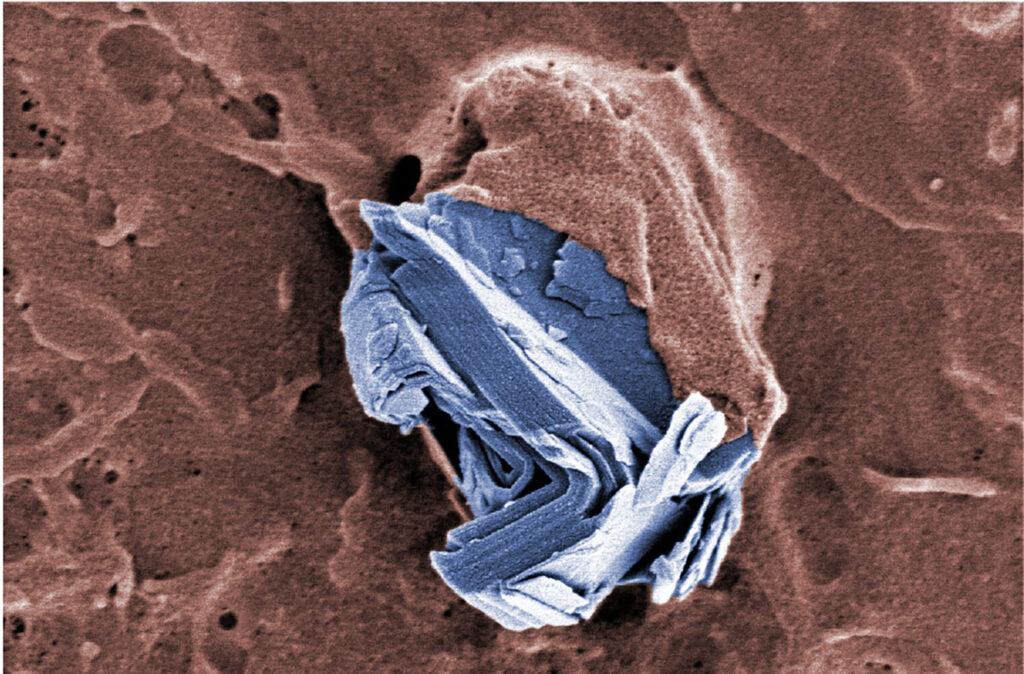Think big. Despite its research topic, this could well be the motto of the Graphene Flagship, which was launched in 2013: With an overall budget of one billion Euros, it was Europe’s largest research initiative to date, alongside the Human Brain Flagship, which was launched at the same time.
The same applies to the review article on the effects of graphene and related materials on health and the environment, which Empa researchers Peter Wick and Tina Bürki just published together with 30 international colleagues in the journal ACS Nano; they summarize the findings on the health and ecological risks of graphene materials, the reference list includes almost 500 original publications.
A wealth of knowledge—which also gives the all-clear. “We have investigated the potential acute effects of various graphene and graphene-like materials on the lungs, in the gastrointestinal tract and in the placenta—and no serious acute cell-damaging effects were observed in any of the studies,” says Wick, summarizing the results.
Although stress reactions can certainly occur in lung cells, the tissue recovers rather quickly. However, some of the newer 2D materials, such as boron nitrides, transition metal dichalcogenides, phosphenes, and MXenes, have not yet been investigated much, Wick points out; further investigations were needed here.
In their analyses, Wick and Co. did not limit themselves to newly produced graphene-like materials but also looked at the entire life cycle of various applications of graphene-containing materials. In other words, they investigated questions such as: What happens when these materials are abraded or burnt? Are graphene particles released, and can this fine dust harm cells, tissues, or the environment?
One example: The addition of a few percent graphene to polymers, such as epoxy resins or polyamides, significantly improves material properties such as mechanical stability or conductivity, but the abrasion particles do not cause any graphene-specific nanotoxic effect on the cells and tissues tested. Wick’s team will be able to continue this research even after the flagship project has come to an end.
In addition to Wick’s team, Empa researchers led by Bernd Nowack have used material flow analyses as part of the Graphene Flagship to calculate the potential future environmental impact of materials containing graphene and have modeled which ecosystems are likely to be impacted and to what extent.
Roland Hischier’s team, like Nowack’s at Empa’s Technology and Society lab, used life cycle assessments to investigate the environmental sustainability of different production methods and application examples for various graphene-containing materials.
A new dimension: Graphene and other 2D materials
Graphene is an enormously promising material. It consists of a single layer of carbon atoms arranged in a honeycomb pattern and has extraordinary properties: exceptional mechanical strength, flexibility, transparency, and outstanding thermal and electrical conductivity. If the already two-dimensional material is spatially restricted even more, for example, into a narrow ribbon, controllable quantum effects can be created. This could enable a wide range of applications, from vehicle construction and energy storage to quantum computing.
For a long time, this “miracle material” existed only in theory. It was not until 2004 that physicists Konstantin Novoselov and Andre Geim at the University of Manchester were able to produce and characterize graphene specifically. To do this, the researchers removed layers of graphite with a piece of adhesive tape until they had flakes just one atom thick. They were awarded the Nobel Prize in Physics for this work in 2010.
Since then, graphene has been the subject of intensive research. In the meantime, researchers have discovered more 2D materials, such as graphene-derived graphene acid, graphene oxide, and cyanographs, which could have applications in medicine. Researchers want to use inorganic 2D materials such as boron nitride or MXenes to build batteries that are more powerful, develop electronic components, or improve other materials.


